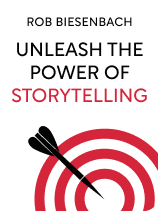

This article is an excerpt from the Shortform book guide to "Unleash the Power of Storytelling" by Rob Biesenbach. Shortform has the world's best summaries and analyses of books you should be reading.
Like this article? Sign up for a free trial here.
Where do story ideas come from? What kinds of characters engage an audience? When you edit, what should you take out?
When you have a message to convey to an audience, it takes time to craft a story that’s perfectly suited for the job. Biesenbach outlines a process you can use to create a story that matches the audience you need to reach and the message you want to deliver.
Keep reading to learn how to craft a story, from finding an idea to editing your draft.
How to Create and Tell a Great Story
After establishing what a good story is and why it’s so powerful, Biesenbach dedicates much of the book to explaining exactly how to craft a story and present it well. He explains that this is a process that anyone can learn.
Step #1: Find Story Ideas
First, start cultivating a collection of stories that speak to your values and engage your areas of expertise. Coming up with a story in a pinch can feel difficult, so Biesenbach recommends noticing the stories that play out in your everyday life. It also helps to stay alert to stories in the books, journals, films, and other narratives you consume—you never know when you’ll run across a story that perfectly illustrates one of your core values. You can also interview people about their stories or plumb your own history for stories that relate to the message you want to convey, like calling on a childhood memory of building a treehouse to talk about collaboration.
(Shortform note: Looking for stories in your everyday life sounds great in theory but can prove challenging. In Made to Stick, Chip Heath and Dan Heath agree with Biesenbach’s recommendation to stay on the lookout for great stories that speak to your work or your mission. Additionally, they recommend imagining that you’re wearing a set of core idea lenses that can help you look at everything from the perspective of the message you need to communicate.)
Step #2: Consider Your Audience
Next, think about your audience and take an inventory of what you know about your listener. Without a specific listener in mind, you’ll have trouble crafting a story that accomplishes your goals. Consider who they are, what they want, what you have in common with them, and what they know about you or what you represent. Also identify what you’d like your audience to do after hearing your story—adopt your idea, purchase your product, get behind your cause—and any challenges that might stop them from doing so, such as limited time and resources or skepticism about your idea.
(Shortform note: Experts agree that you need to know your audience to craft a compelling story. Vanessa Chase Lockshin, the author of The Storytelling Nonprofit, writes that telling a story about your cause or organization will work only if you get to know the audience who will be listening to that story. She recommends going through a discovery process, including talking to real people, to learn who your audience really is. You can even construct a fictional audience member to make the details more concrete in your mind.)
Step #3: Choose Your Character, Goal, Obstacles, and Resolution
Once you have a story and an audience in mind, take some time to think about the character at the heart of your story. Because your character should help you overcome the challenges or objections you anticipate your audience having, the character needs to be relatable to your listeners. Plus, the resolution of the story—where the character either does or doesn’t overcome the obstacles that block the path to the goal—should drive your message home.
For example, let’s say that you own an apple orchard and need to tell a story that convinces people to buy your apples—but they find apples boring. So when you talk about your grandfather, who planted the orchard, you could explain how he envisioned an orchard full of odd varieties of apples: not Honeycrisp, Gala, or Granny Smith, but Black Oxford, Pink Pearl, or Mountain Rose apples. He likely faced many obstacles: Maybe he had trouble sourcing saplings, dealt with a rare beetle infestation, or felt doubted by other farmers. But when your story reaches the resolution of an orchard full of apples, your listeners appreciate the vision and the care it took to establish and tend that apple orchard.
(Shortform note: It’s crucial to take time to choose the right character because you can’t separate story and character. In How To Read Literature Like a Professor, Thomas C. Foster explains that the plot of a story is driven by the nature of the character. As a literature professor, Foster is talking about the character in the context of a book-length narrative. But he notes that to hold the audience’s attention, a character needs to grow or change—a useful insight for a story of any length. Without growth or change on the part of the character, the obstacles won’t feel challenging, the goal won’t feel worthy of the character’s pursuit, and the ending of the story won’t feel satisfying. The right character sets all of those pieces in motion.)
Step #4: Structure and Focus Your Story
Once you’ve chosen a character and you know the basics of what will happen to him, you need to craft the structure of your story. Structure gives shape to the story so that it has conflict and draws the reader into the action. Stories can adopt many different structures, but Biesenbach suggests starting with a simple one that includes:
- Normal state (the status quo)
- Inciting incident (the event that upsets the status quo)
- Turning point (the action the character takes to respond to the inciting event)
- Conflict (the obstacles that complicate the character’s path)
- Resolution (the conclusion, where the character either gets what they want or doesn’t, but in either case learns something)
| Understanding Classic Story Structure Biesenbach’s basic story structure corresponds closely to a classic description of narrative structure. Freytag’s Pyramid, developed by novelist Gustav Freytag, describes a story in five key stages: Exposition, Rising Action, Climax, Falling Action, and Resolution. In the Exposition, the writer builds the world of the story. In the Rising Action, the writer introduces the conflict. In the Climax, the conflict reaches its peak. In the Falling Action, the writer lays out the consequences of the conflict and its climax. In the Resolution, the writer shows how the character or the world is changed by the events of the story. Of course, not every literary work follows Freytag’s Pyramid, and this might not be the right structure for every story you tell. However, this structure is worth understanding because it serves not only as an example of what story structure is but how the structure functions as a conceptual framework for a story. Meander, Spiral, Explode author Jane Alison notes that while Western literature adopted the convention of a causal arc—the movement from rising conflict to climax to resolution—fiction has taken very different shapes in other cultures. Chinese fiction, for instance, has long emphasized lyricism, pattern, repetition, and rhythm. One traditional East Asian structure called Kishōtenketsu de-emphasizes tension and instead highlights character development, with a four-act structure that includes an introduction, development, twist, and conclusion. |
Step #5: Use Emotion to Hook Your Audience
Then, when you’ve nailed down the structure, evaluate how your story can tap into listeners’ emotions. Much of a story’s power lies in its ability to make us feel something, and Biesenbach explains that you can use emotion to engage your audience in a few ways.
First, consider what motivates you: Focus less on “what” you do and more on “why” you do it to help center the story on things that matter. If you’re talking about a company or a product, identify the human element in the connections between colleagues or the ties between workers and their communities. You can also connect your story to the values that you and your audience share by emphasizing the importance of community, connecting the story to the values you share, or tapping into the history that unites the members of your audience.
For example, if you’re trying to get people behind an initiative to clean up a local park, you could focus less on the specific steps you’ll need to take and more on the reasons to take on the project in the first place (like preserving a public gathering space or ensuring the park continues to be a hospitable home for endangered birds). You can appeal to your audience’s sense of community by reminding them that all of you consider the neighborhood your home, and together you can take care of that home for everyone’s benefit.
Biesenbach notes that in some cases, it can work to highlight an emotionally resonant lesson in the struggles of a leader, historical figure, or athlete you look up to. (Just watch out for clichés.) And at points throughout your story, it’s OK to express your own emotions: When you talk about the people, memories, and values that you find meaningful, you reveal your own humanity.
(Shortform note: A story you feel passionate about can engage your audience—but only if you enable them to share in the emotions you feel. Essayist Rebecca Solnit cautions that when you tell a story that fires up your emotions, you need to stay conscious of not using up all of the emotion of the story by fixating on those feelings to the exclusion of all other perspectives. Especially when you feel strongly invested in the issue you’re communicating about, you have to leave room for your listeners to feel their own emotions about the story. Keep your focus on presenting a clear point of view, not only telling people how they should feel about an issue.)
Step #6: Edit Your Story
Finally, it’s time to edit your story. Include only what’s necessary, or else extraneous details will detract from your message and mute the impact of your story. Biesenbach recommends that you stay on message, focusing on the point you want to make with the story and eliminating any details that don’t serve that point. It’s also a good idea to check that you’ve zoomed in on a single character and streamlined the cast of characters in the story as much as possible.
In order to establish a clear cause and effect, which helps the listener follow the logic of your story, make sure that your narrative has just one turning point. Eliminate any confusing twists and turns. Throughout the story, make sure that you’re using detail judiciously. A time and place can set the scene, and sensory details help make the events of the story more vivid, but you can simplify dates, round numbers, and eliminate proper nouns to sharpen the focus.
(Shortform note: Storytellers can learn something about the importance (and process) of editing from writers. Novelist Alexander Chee offers some advice that’s intended for writers but can also point you in the right direction when you’re preparing a verbal story. Chee recommends writing to the end of the story before making any cuts or edits. Then, revise your story on paper if you can. Or, refer to your printout and retype the entire story to see if a better arrangement occurs to you. Finally, redraft to add any missing pieces and cut anything redundant.)

———End of Preview———
Like what you just read? Read the rest of the world's best book summary and analysis of Rob Biesenbach's "Unleash the Power of Storytelling" at Shortform.
Here's what you'll find in our full Unleash the Power of Storytelling summary:
- How telling a story can make any message more compelling
- The unique power stories have to influence us and shape our emotions
- The crucial pieces that make up a story (other than the beginning, middle, and end)






